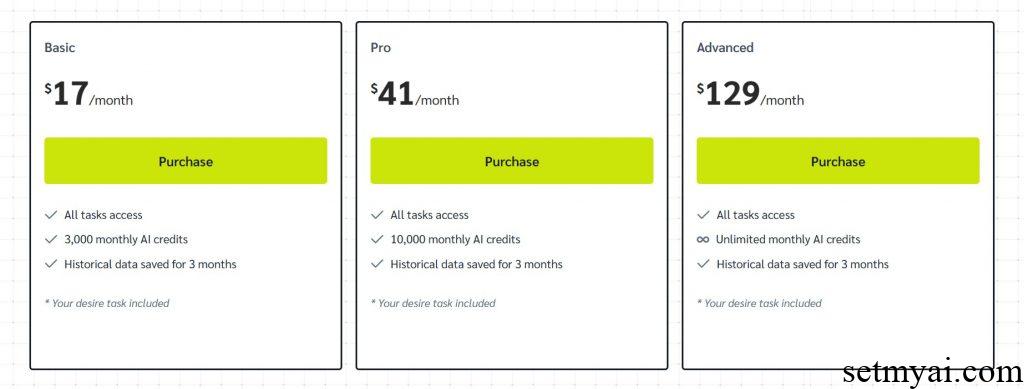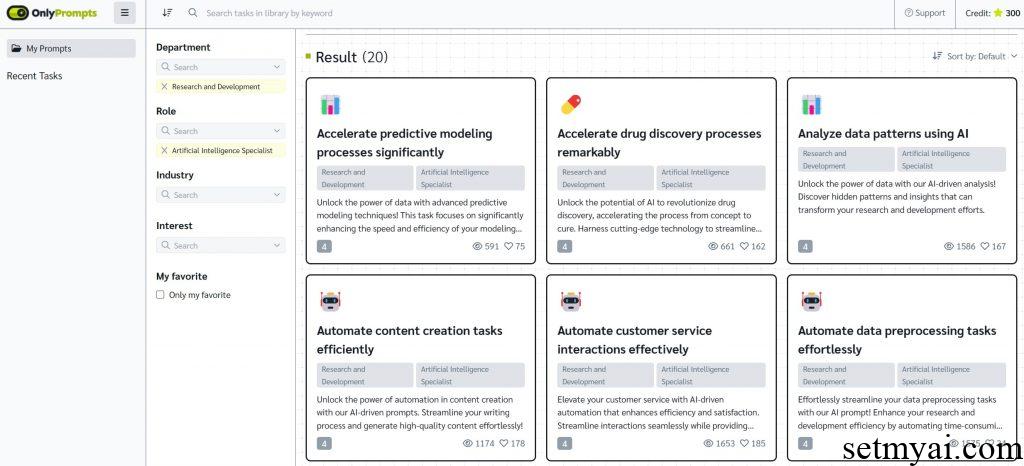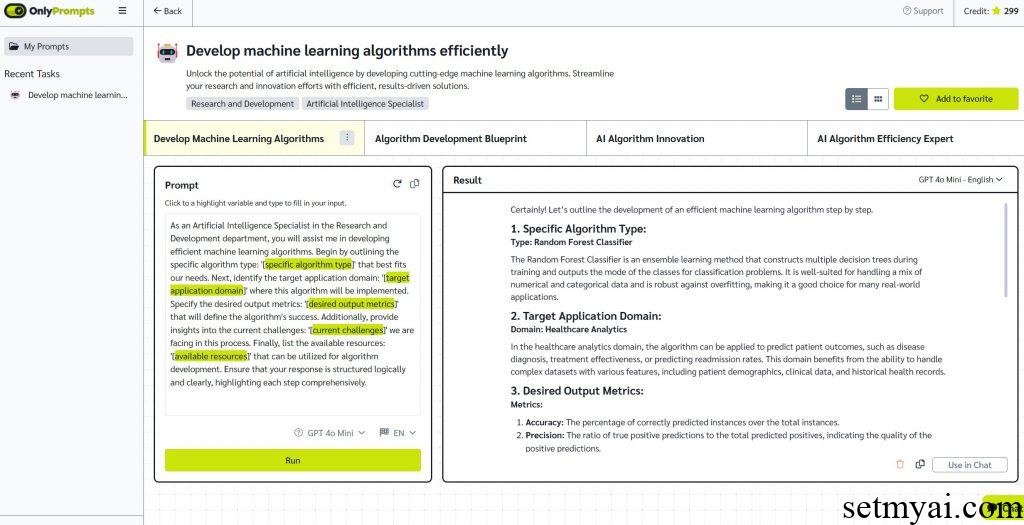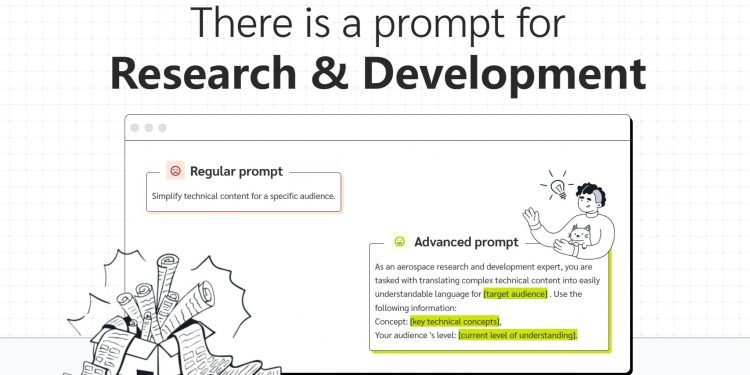Introduction to OnlyPrompts
OnlyPrompts is an AI platform that includes over 150000 Prompts, allowing users to search for them and solve over 30000 tasks.
OnlyPrompts offers both free and paid versions, with the free version having 300 credits. Using different AI models will consume different amounts of credits each time. The paid version allows for the purchase of more credits.
Related Post: PromptPort a Platform that Contains 5,000 Prompts

How to Use OnlyPrompts
We use OnlyPrompts to search for Prompts related to artificial intelligence algorithms. OnlyPrompts has classified different Prompts into various categories and provided filtering functionality. We can filter from the perspectives of departments, roles, industries, and interests, or we can filter by entering keywords from the search bar at the top of the page. OnlyPrompts provides a large number of choices for each filtering dimension, which can basically cover users’ daily search needs.

After setting up the filter, OnlyPrompts provides some Prompts related to artificial intelligence research. We click on Develop machine learning algorithms efficiently to enter the specific page. We can modify keywords from the page and use AI to generate results. OnlyPrompts offers over ten different AI models and dozens of languages. After completing the modifications, click Run to view the results provided by the AI.
As an Artificial Intelligence Specialist in the Research and Development department, you will assist me in developing efficient machine learning algorithms. Begin by outlining the specific algorithm type: ‘[specific algorithm type]’ that best fits our needs. Next, identify the target application domain: ‘[target application domain]’ where this algorithm will be implemented. Specify the desired output metrics: ‘[desired output metrics]’ that will define the algorithm’s success. Additionally, provide insights into the current challenges: ‘[current challenges]’ we are facing in this process. Finally, list the available resources: ‘[available resources]’ that can be utilized for algorithm development. Ensure that your response is structured logically and clearly, highlighting each step comprehensively.
Certainly! Let’s outline the development of an efficient machine learning algorithm step by step.
### 1. Specific Algorithm Type:
**Type: Random Forest Classifier**
The Random Forest Classifier is an ensemble learning method that constructs multiple decision trees during training and outputs the mode of the classes for classification problems. It is well-suited for handling a mix of numerical and categorical data and is robust against overfitting, making it a good choice for many real-world applications.
### 2. Target Application Domain:
**Domain: Healthcare Analytics**
In the healthcare analytics domain, the algorithm can be applied to predict patient outcomes, such as disease diagnosis, treatment effectiveness, or predicting readmission rates. This domain benefits from the ability to handle complex datasets with various features, including patient demographics, clinical data, and historical health records.
### 3. Desired Output Metrics:
**Metrics:**
– **Accuracy:** The percentage of correctly predicted instances over the total instances.
– **Precision:** The ratio of true positive predictions to the total predicted positives, indicating the quality of the positive predictions.
– **Recall (Sensitivity):** The ratio of true positive predictions to the actual positives, measuring the algorithm’s ability to identify all relevant instances.
– **F1 Score:** The harmonic mean of precision and recall, providing a balance between the two metrics.
– **AUC-ROC Curve:** The area under the Receiver Operating Characteristic curve, which illustrates the trade-off between sensitivity and specificity.
### 4. Current Challenges:
**Challenges:**
– **Data Quality:** Incomplete or noisy data can significantly impact the performance of the Random Forest algorithm. Preprocessing and data cleaning are essential but can be resource-intensive.
– **Feature Selection:** The presence of irrelevant or redundant features can lead to overfitting. Identifying the most important features requires careful analysis and potentially additional techniques.
– **Imbalanced Data:** In healthcare, certain outcomes may be rare, leading to imbalanced datasets. This can skew the results and affect the accuracy of the model. Techniques like SMOTE (Synthetic Minority Over-sampling Technique) may be needed to address this.
– **Interpretability:** While Random Forests provide good performance, they can be less interpretable than simpler models, which may be a concern in healthcare settings where understanding the decision-making process is crucial.
### 5. Available Resources:
**Resources:**
– **Data Sources:** Access to electronic health records (EHRs), clinical databases, and public health datasets for training and testing the model.
– **Computational Resources:** High-performance computing clusters or cloud-based platforms (e.g., AWS, Google Cloud) to handle the computational demands of training the model, especially with large datasets.
– **Software Libraries:** Utilization of machine learning libraries such as Scikit-learn (Python), TensorFlow, or PyTorch for model implementation and evaluation.
– **Expertise:** Collaboration with healthcare professionals and data scientists to ensure that the model is grounded in clinical relevance and addresses real-world problems effectively.
By following this structured approach, we can develop an efficient Random Forest algorithm tailored to the healthcare analytics domain, ultimately improving patient outcomes and operational efficiencies.

Summary
As an AI platform that includes over 150000 Prompts, OnlyPrompts is able to provide users with high-quality Prompts. SetMyAI recommends users interested in writing Prompts to use this tool.
Website:








